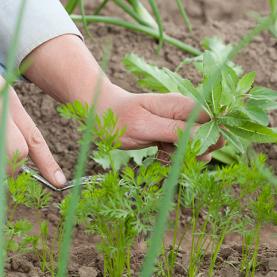Watermelon
Watermelons are native to Africa and became popular all over the world thanks to their easily transportable seeds and tasty, thirst-quenching qualities. They are now cultivated intensively and, since they are sensitive to changes in temperature, they are generally grown under cover. In Japan, watermelons are also valued for their aesthetic properties and, moulded into the shape of a cube, pyramid or sphere, become luxury decorative items.
When wayfaring watermelons sought new horizons
Watermelons have been cultivated in various regions of Africa since Antiquity, in particular by the Egyptians in the Nile Valley. The seeds being easy to transport, the practice of cultivating watermelons expanded from Mesopotamia to India and the Far East.
During the same period in Europe, consumption of watermelon remained confined to the Mediterranean region with its favourable climate for growing the fruit, particularly along the coastline. In the 15th and 16th centuries, the British discovered watermelons in Madagascar and exported them to Central Europe and to British colonies on the American continent.
Watermelons are currently among the most popular seasonal fruit in the world. They are often associated with summer heat thanks to their thirst-quenching properties, as watermelon flesh is over 90% water.
Growing watermelons
Watermelons are grown outdoors, but intensive production favours growth under cover (in a greenhouse or polytunnel) as this enables the plants to be sown in winter and the fruit to be harvested in April and July. However, in order to obtain high-quality fruit in terms of nutrition and flavour, it is vital that the temperature remains constant while the plants are growing.
Watermelons have a five-stage crop cycle: seeding, sprouting, pruning, fruiting and harvesting. Between these stages, the plants must be regularly treated and watered. Watermelon seeds are sown in the earth and they use their roots to seek out a large quantity of nutrients. The stems lengthen and sprout buds and leaves. To enable the fruit to develop properly, as the plants begin to grow some buds are removed by hand. It is important to prune the plants so that they do not become too overgrown. A few months after seeding, the first fruit appears, already round in shape. When watermelons are ripe, they are harvested by hand and placed in transport crates, before reaching the storage area where they are weighed, cleaned and kept before they are sold.
Jupiter, Reina, Sugar Baby, just some of the varieties of watermelon
There are numerous varieties of edible watermelon: watermelons for jam, mini watermelons, the apyrena or seedless (Jupiter, Reina and Negra) and those with red flesh (Crimson Sweet and Charleston Gray). The common watermelon (Sugar Baby) is the most eaten variety. Several offshoots of very irregularly shaped foliage twist themselves around its stem, which can grow up to two and a half metres in length. The fruit has a thick skin (dark green, pale green or marbled) and is round in the wild and oval in the case of some cultivated varieties.
Watermelons must be eaten straight away, just after harvesting. They are seldom transformed into by-products, apart from juice and jam, but can be used as an extract to flavour ice cream, yoghurts and drinks.
The ‘watery melon’ and the cube-shaped watermelon
The origin of the term ‘watermelon’ comes from a misunderstanding between the British explorers and the natives of Madagascar, who introduced the fruit to them as a refreshing ‘watery’ melon.
Nowadays, in Asia, young watermelons are sometimes put into a mould to give them a particular shape. However, although the mould optimises the transportation and storage of the fruit, its shape prevents the fruit from fully ripening and alters the taste and nutritional qualities. Therefore, in Japan, the high price of cube, pyramid and sphere-shaped watermelons render them luxury products or purely decorative fruit.
Organisation des nations unies pour l'alimentation et l'agriculture | FAO, 1998. Cultures protégées en climat méditerranéen. Production végétale et protection des plantes. Volume 90, 1998. FAO : Éditions Food & Agriculture Org. ISBN 978252027195
JEANGUYOT, Michelle, SÉGUIER-GUIS, Martine, 2004. L’herbier voyageur : histoire des fruits, légumes et épices du monde. Toulouse : Éditions Plume de carotte. ISBN 9782951662971
PITRAT, Michel et FOURY, Claude, 2015. Histoire de légumes : des origines à l’orée du XXe siècle. Paris : Éditions Quae. ISBN 9782759223558.






